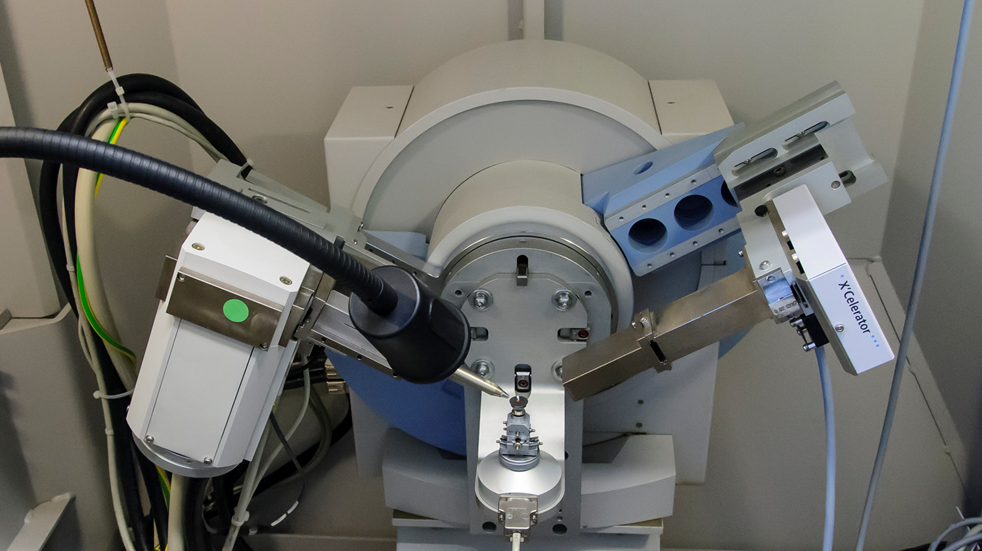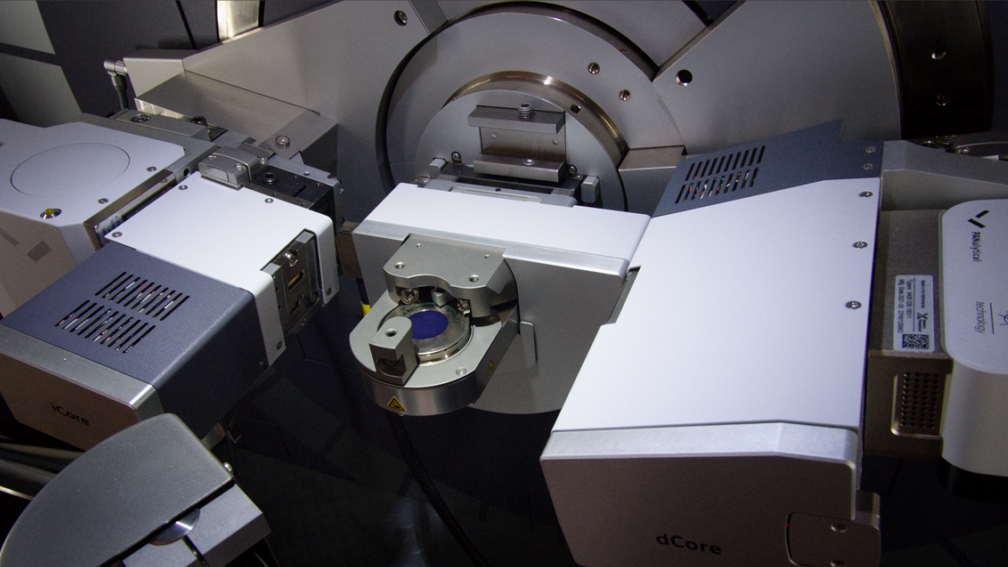SEM (Scanning Electron Microscope) Jeol JSM-6510
Contact persons: Pavlína Fialová, Jan Šubrt
The JEOL JSM-6510 scanning electron microscope allows secondary and backscattered electron modes to be measured. The microscope can operate in both high-vacuum and low-vacuum modes. The low-vacuum mode enables the observation of non-conductive samples without the need for surface coating. The microscope has an SDD x-act 10mm² EDS detector from Oxford Instruments, which can detect elements from boron to plutonium.
TEM (Transmission Electron Microscope) Jeol JEM-3010
Contact person: Natalija Murafa
The transmission electron microscope is the only laboratory instrument capable of simultaneously providing information on the structure, elemental composition, and morphology of particles in a region as small as a few nanometers of the studied sample. The JEM-3010 transmission electron microscope from JEOL allows the study of material structures with atomic resolution, both in direct imaging (HRTEM) and through electron diffraction (SAED, CBED, NBED). The microscope is equipped with an EDX detector from Oxford Instruments, enabling elemental analysis with nanometer resolution. The attached DigiStar system from NanoMegas provides maps of crystallographically distinct phases and crystal orientations at the nanometer scale.
Quantachrome Instruments NOVA 4200e
Contact persons: Pavlína Fialová, Eva Pližingrová
The NOVA 4200e surface area and pore size analyzer from Quantachrome allows the simultaneous measurement of 3 samples. Nitrogen gas adsorption is measured at a temperature of -196 °C. The analyzer can also determine the external specific surface area, total pore volume, and average pore radius. From a maximum 100-point adsorption/desorption isotherm, the BJH pore size distribution can be determined. The compatible FloVac Degasser is used for sample pretreatment, allowing for both evacuations at elevated temperatures up to 300 °C and purging samples with nitrogen gas.
Belsorp-max II
Contact persons: Darina Smržová, Pavlína Fialová
The Belsorp instrument allows for determining surface area and porosity in mesoporous and microporous materials. Nitrogen or water vapours are used for gas adsorption measurements.
SETARAM SETSYS EVOLUTION-16-MS
Contact persons: Anna Vykydalová, Pavla Kurhajcová
The SETARAM thermal analyzer allows for measuring samples in inert (argon) and air atmospheres at temperatures up to 1300 °C. In addition to the thermogravimetric signal, a DTA (Differential Thermal Analysis) record is captured simultaneously. A sophisticated system connects the QMS module to a mass spectrometer for the analysis of released gases. The mass spectrometer can operate in either MID (multiple ion detection) or SCAN mode.
Netzsch STA 449 F1 Jupiter
Contact persons: Anna Vykydalová, Pavla Kurhajcová
The Netzsch thermal analyzer, which could be connected with gas chromatography (Agilent Technologies 7890B GC system) or mass spectrometry (Agilent Technologies 5977B MSD), is a sophisticated system capable of simultaneous TGA/DSC and GC-MS measurements. Measurements can be performed in inert (argon) and air atmospheres, with a maximum temperature of up to 1600 °C. This system is used to detect changes in materials under dynamic or isothermal conditions. It can also analyse gases that are generated or released from the material under thermal stress. The evolving gases during measurement can be analyzed using gas chromatography or directly via mass spectrometry (using either selected m/z values or scan mode).
FT-IR spectrometer Nicolet iS50
Contact persons: Pavla Kurhajcová, Petra Ecorchard
Spectral range: 100 - 4000 cm-1
Detector DlaTGS/KBr, DlaTGS/PE, Ge/KBr beamsplitter
Single reflection attenuated total reflection (ATR) Diamant, Ge, ZnSe crystal.
Wafers for transmission measurements - ZnSe, Si, Sapphire, KBr.
Possible measurement with KBr tablets, Si plate etc., measurements of liquids
Liquid cuvette 32 mm, KBr and BaF2 windows
Nujol cuvette 25 mm, KBr, PE and BaF2 windows, nujol, KEL-F
Software OMNIC 9
HRSEM FEI NanoSEM 450
Contact persons: Jiří Henych, Petra Ecorchard
This high-resolution scanning electron microscope allows for capturing high-quality images of shapes, morphology, defects, or agglomerates of particles, even at the nanometer scale. Observation is enabled by the Everhart-Thornley detector or in low vacuum (10-200 Pa) using the Through-the-Lens mode. The instrument allows tilting of the sample within a range of -15 to 75°. The voltage is selectable in the range of 1-30 kV. The Field-Free mode makes measurements and recordings of magnetic samples possible. For even better resolution, measurements can be performed in immersion mode. The EDS detector provides a qualitative and quantitative determination of the present elements, which also offers the capability of graphical elemental mapping.
HRTEM FEI Talos F200X
Contact persons: Jan Tolasz, Natalija Murafa
The microscope is equipped with an FEI X-FEG electron source with high brightness, which can operate at the accelerating voltage of 80 to 200 kV. It features a Super-X EDS system with four silicon drift detectors (SDD) for precise and quantitative energy-dispersive X-ray spectroscopy (EDX) analysis, and selected area electron diffraction (SAED) that utilizes constructive interference of scattered electrons to produce diffraction patterns, useful for examining the crystal structure of materials. The double-tilt, low-background sample holder can be used for more specific applications due to additional sample movements and the use of beryllium components for X-ray analysis with a low background signal.
The FEI Talos F200X combines high-resolution S/TEM (scanning/transmission electron microscopy) and TEM with energy-dispersive X-ray spectroscopy (EDS) for chemical characterization and elemental composition mapping. In STEM mode, the HAADF (high-angle annular dark-field) detector can be used. This technique generates images by collecting scattered electrons with an annular dark-field detector and is sensitive to changes in the atomic number of atoms in the sample (Z-contrast imaging).
The Talos platform is fully digital and also allows for the addition of application-specific detectors or sample holders for dynamic experiments. Rapid TEM imaging on the Talos supports high-resolution and in situ dynamic observations. The FEI Ceta 16Mpix camera provides a large field of view and quickly captures images.
Benchtop X-ray powder diffractometer Panalytical Aeris
Contact person: Michal Navrátil, Petra Ecorchard
Range of 2θ between 1°and 142°
Cu Kα X-ray tube
1Der detector
Bragg-Brentano geometry, Transmission geometry
Measuring the powders, and samples on a silicon plate, under Kapton foil, and in capillary
Data evaluation in the software HighScore 4.9


X-ray powder diffraction
Contact person: Petr Bezdička
Our laboratory has three X-ray powder diffractometers: two X'PertPRO MPD (Multi-Purpose Diffractometer) instruments from PANalytical and a third instrument, the Empyrean, series 3, from Malvern PANalytical.
The first is equipped with a cobalt X-ray tube and a fast linear position-sensitive detector, the X'Celerator. The conventional Bragg-Brentano reflective arrangement is primarily used to analyse samples with a high iron content. An in-situ high-temperature chamber (Anton Paar HTK 16) or an analysis chamber with controlled humidity (Anton Paar CHC+ chamber) can be installed. The reflective geometry can also be replaced with microdiffraction geometry, which allows for the non-destructive analysis of small heterogeneous micro-samples, typically those taken from works of art. In this geometry, a monocapillary with an output diameter of 0.1 mm is used in the primary beam.

Fig.1: PANalytical XPertPRO MPD with Co X-ray tube
The second instrument has a copper X-ray tube and the PIXCel detector. It allows for sample analysis in transmission geometry in addition to analyses in conventional reflective geometry. This is particularly advantageous for the more accurate identification of clay minerals, where complementary analyses in both reflective and transmission setups enhance the precision of determining these minerals and their polytypes.

Fig. 2: PANalytical XPertPRO MPD with Cu X-ray tube
The third instrument has a cobalt X-ray tube, universal programmable optics (iCore/dCore), and a PIXCel 3D detector. The instrument features an automatic sample changer with 45 positions, allowing us to analyse of large series of diverse samples. Additionally, the diffractometer is equipped with a programmable X, Y, Z platform with a fully automatic focusing on the analyzed point. This accessory can be used for non-destructive analysis of solid samples, such as ceramics, construction materials, and small works of art, typically portrait miniatures and archaeological samples. The instrument is also equipped with a monocapillary with an output diameter of 0.1 mm and a polycapillary with an output diameter of 0.05 mm for microdiffraction analyses.

Fig. 3: Malvern PANalytical Empyrean, series 3 with Co X-ray tube
Cooperation within the NanoEnviCz project (MEYS):
Contact person: Petra Ecorchard
Web site: www.nanoenvicz.cz/en
NanoEnviCz is a research infrastructure that has connected the capacities of several scientific organizations in the Czech Republic in the field of nanomaterials and nanotechnology research. It provides an open access to its experimental facilities and professional, qualified services. The entire network of six institutions can be utilized, which includes the J. Heyrovský Institute of Physical Chemistry of the Czech Academy of Sciences, the Institute of Inorganic Chemistry of the Czech Academy of Sciences, the Institute of Experimental Medicine of the Czech Academy of Sciences, Jan Evangelista Purkyně University in Ústí nad Labem, Palacký University Olomouc, and the Technical University of Liberec.
Within IIC is possible to apply for:
UACH1 - AFM/MFM/EFM microscope
UACH2 - Liquid chromatograph with diode-array detector (HPLC-DAD) Dionex Ultimate 3000
UACH4 - High-resolution scanning electron microscope FEI Nova NanoSEM™450
UACH5 - Surface areas determination (BET)
UACH8 - FTIR - DRIFT (diffuse reflectance monitoring)
UACH9 - DXR Raman Microscope
UACH10 - Transmission electron microscope JEM-3010
UACH12 - Precision ion polishing system GATAN
UACH14 - Multipurpose X-ray powder diffraction
UACH15 – Thermal analyser connected to mass spectrometer
UACH16 - High resolution Transmission electron microscope FEI Talos F200X
UACH17 - X-ray powder diffractometer, Co radiation Malvern PANalytical Empyrean III
UACH18 - Benchtop X-ray powder diffractometer Panalytical Aeris